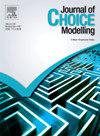Using Lagrange multiplier type tests to detect structural intra-person heterogeneity in composite marginal likelihood estimation in panel data sets
IF 2.4
3区 经济学
Q1 ECONOMICS
引用次数: 0
Abstract
Gradient-based Lagrange multiplier-type tests represent a valuable tool for discriminating between nested models, obviating the necessity to estimate the unrestricted model. This is particularly advantageous when testing for pooling in panel data sets, as it permits the testing of multiple groupings without the necessity of re-estimating the model for each grouping. This makes the process considerably faster and more flexible in comparison to Wald or likelihood ratio type tests.
In this paper, we demonstrate that the use of pairwise composite marginal likelihood (CML) estimation enables the comparison of gradients between different CML contributions of pairs of observations for individuals. This allows for the testing of pooling over time, as well as the identification of neglected temporal correlation. The CML approach thus offers a degree of flexibility that is not present in the classical likelihood setting.
Theoretical derivations of the asymptotic distribution of the test statistics under the null hypothesis are provided for the special case of multinomial probit models, thereby forming the basis for the statistical interpretation of the test statistic.
Moreover, a comprehensive simulation study was conducted to assess the finite-sample performance of the test statistics. In particular, the distribution of the test statistic under the null hypothesis and the rejection rates of the tests under various types and degrees of violations of the null hypothesis were evaluated using synthetic panel data sets of varying sizes. This empirical evaluation provides insights into the effectiveness and reliability of the proposed tests in detecting intra-personal heterogeneity and into causes of misspecifications in the deterministic utility structure.
使用拉格朗日乘数型检验检测面板数据集复合边际似然估计中的结构性内部异质性
基于梯度的拉格朗日乘数型检验是区分嵌套模型的一种有价值的工具,避免了对不受限制模型进行估计的必要性。当在面板数据集中测试池时,这是特别有利的,因为它允许测试多个分组,而不需要为每个分组重新估计模型。与Wald或似然比类型测试相比,这使得该过程更加快速和灵活。在本文中,我们证明了使用成对复合边际似然(CML)估计可以比较个体对观测值的不同CML贡献之间的梯度。这允许测试池随着时间的推移,以及识别被忽视的时间相关性。因此,CML方法提供了经典似然设置中不存在的一定程度的灵活性。对于多项式概率模型的特殊情况,给出了零假设下检验统计量渐近分布的理论推导,从而为检验统计量的统计解释奠定了基础。此外,还进行了全面的仿真研究,以评估测试统计量的有限样本性能。特别是,使用不同大小的合成面板数据集评估了零假设下检验统计量的分布以及不同类型和违反零假设程度下检验的拒绝率。这一实证评估提供了洞察的有效性和可靠性,在检测个人内部异质性和确定性效用结构的错误说明的原因所提出的测试。
本文章由计算机程序翻译,如有差异,请以英文原文为准。
求助全文
约1分钟内获得全文
求助全文

 求助内容:
求助内容: 应助结果提醒方式:
应助结果提醒方式:


